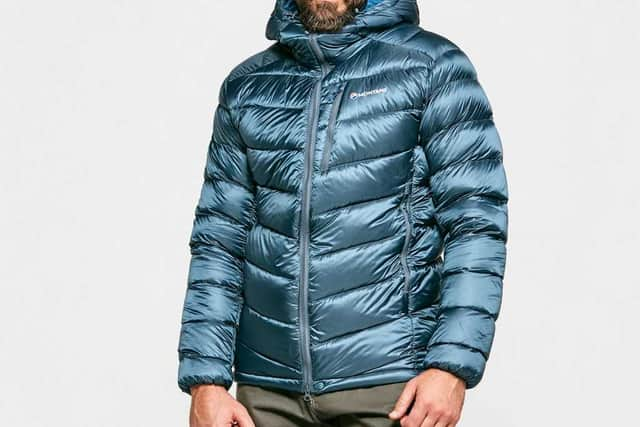Thermal clothing: what to wear to stay warm for outdoor walks and meet-ups this winter
This article contains affiliate links. We may earn a small commission on items purchased through this article, but that does not affect our editorial judgement.


Thermal clothing sales have spiked in the UK in recent months, and it is easy to deduce why.
With the weather dropping to record lows and varying restrictions across the UK prohibiting socialising, we've had to bundle up to try and take socially distanced walks with our friends, or sit in the backyard talking to relatives. So many indoor activities are not allowed at the moment, which means taking to the great outdoors is vital for our mental health and well-being.
Advertisement
Hide AdAdvertisement
Hide AdWith that in mind, it's worth considering the best way to stay warm outside, especially as the temperatures are only likely to get colder. Here is what to look for in thermal clothing, to keep you delightfully comfortable as you endeavour out this winter.
Layering - thermal under layers
When trying to stay warm outside, layer your clothing, and do what you can to minimise perspiration. When sweat accumulates on your skin, it chills you, which is why breathable clothing with sweat-wicking fabrics are a sound investment. Layering these lighter under-layers, and you can remove or add items as your body warms or cool, cutting down on chilling sweats.
Cotton is a poor option when outside - it doesn't wick away sweat, and denim is no friend of the winter outdoors. Thick leggings are a smarter bet.
The most popular option for under-layers is merino wool, which is breathable, thin, and insulates heat, keeping you warmer. They're also good at masking the smell of cooled sweat (within reason, don't abandon hygiene altogether). The range of merino under-layers from Marks and Spencer is good for everyday wear.
'SmartWool' is merino wool that's been prepared with a 'proprietary treatment,' in order to make the wool resistant to shrinking, odor, and bacteria. Our own SmartWool socks have been hiking in the Dolomites, on the Camino de Santiago de Compestela, and on winter-morning mercy dashes to the corner shop, and they have remained cosy and smell-free. They're our top tip for winter socks.
'HeatTech', from Uniqlo, is a synthetic fibre that traps warms air, similar to heavy wool, but lightweight. They've also been treated to insure they're soft. Don't baulk at the term 'synthetic' - these are an excellent low-price layering option. They also have the benefit of looking like standard wardrobe staples, so they're good for coordinating with your regular clothes.
Bamboo clothing is has risen in popularity over the past five years, for just cause. Three times more absorbent than cotton, it wicks moisture away from the skin, keeping you comfortable. It feels luxuriously soft - this is the most comfortable under-layer fibre we've found, and because it is moisture-wicking it's an odor-resistant fabric. Bamboo plants also absorb CO2 from the air, so this is a sustainable, carbon-footprint friendly choice.
When layering, wear your most snug-fitting shirt closest to your body, with looser garments on top. That snug under-layer will help keep you insulated.
Advertisement
Hide AdAdvertisement
Hide AdFor thermal underwear, we recommend shopping at Landsend, Mountain Warehouse, or M&S
Hats
No, you do not lose most of your heat through your head. Nevertheless it behoves you to keep your head warm while you're out for a stroll. No need to reinvent the wheel - a woollen hat works just fine, thought we would advocate for one that dries quickly and is anti-bacterial, which often equates to a merino beanie.
That said - we have to confess to spending all of the time we are outside in winter wearing a cashmere beanie from Hush, because they're so sumptuously soft. And if you want to keep your ears warm, a deerstalker - so pleasingly old-fashioned - is your best bet. Barbour make terrific deerstalkers, with a waxed cotton outer to keep the rain off.
Insulated Jackets


In terms of wearing a jacket to keep you warm, there are a plethora of options, but we prefer down jackets to padded wool jackets, knitted jackets, or those with a synthetic fill.
This is because a good down jacket will manage to be warm, as well as lightweight. Indeed, chose wisely and they'll offer packability, wet weather protection, and breathability into the bargain.
Down refers to the layer of fine feathers found on ducks and geese, beneath their tough, outer feathers. Studies have shown geese down to be more thermally efficient than duck, so it is pricier (but warmer!).
Similar to a duvet's tog, a down jacket's 'fill power' indicates how warm the jacket will be. Look for a 750 fill power at least - although 1000 is premium.
'Baffle construction' refers to the way that a down jacket is sewn, to lower the chances of heat escaping through stitching. The warmest option is the 'box wall' baffle - though this tends to result in a puffier, heavier looking jacket.
Advertisement
Hide AdAdvertisement
Hide AdEither look for a waterproof option (durable water repellent coating - DWR - should be on the labelling) or plump for a outer shell (see below), as down itself is ineffective when wet.
Which jacket you chose depends on your own personal aesthetic, but the most reliable retailers for down jackets are Mountain Warehouse, Tiso, Cotswold, and Blacks.
If you're after a specific recommendation, we have had a woman's RAB Variance for several years, and it's impressively light-weight, cosy, and not-too-puffy. For menswear, a hiker we know swears by his stylish Montane Anti-Freeze Down Jacket.
Snood
Scarves - as good as they can be for accessorising - are not necessarily the best option for keeping warm outdoors. The benefit of a snood is that they sit closer to your neck, and tuck more readily into jackets, providing better insulation. In the current age, as well, you can pull a snood up over your lower face to double as a face mask for when you head into a corner shop for supplies.
Waterproof outerwear
There's something seductive about shopping for down jackets and merino underwear, with their promise of toastiness and nerdy specs to swat up on (oo, yes please, 750 fill power and narrow baffle construction).
However, wet cold is infinitely worse than dry cold, so if you're stomping around in the inclement, make sure you have a waterproof outer 'shell'. Gore-tex is beloved of winter walkers, for good cause - their outerwear is windproof, water resistant, and breathable. Some people call them stylish, but with outdoor clothing, we're talking in relative terms - Gore-tex isn't cat-walk ready, but we're gunning for practicality.
They are not cheap - £150 is the lowest price we've found, but they last multiple seasons and work brilliantly, so they are a good investment if you're fond of winter walking.
Heated Glove Liners
Heated glove liners are an excellent addition to a winter wardrobe. Battery powered, they fit easily within skiing, hiking, or motorcycle gloves, and can provide three heat levels to fingers for two hours. We particularly advise these if you suffer from mild arthritis, as they're known to alleviate symptoms by increasing blood flow to the hands.
Advertisement
Hide AdAdvertisement
Hide AdA version of this article was originally published on our sister website, Yorkshire Evening Post
This article contains affiliate links. We may earn a small commission on items ordered through this article.